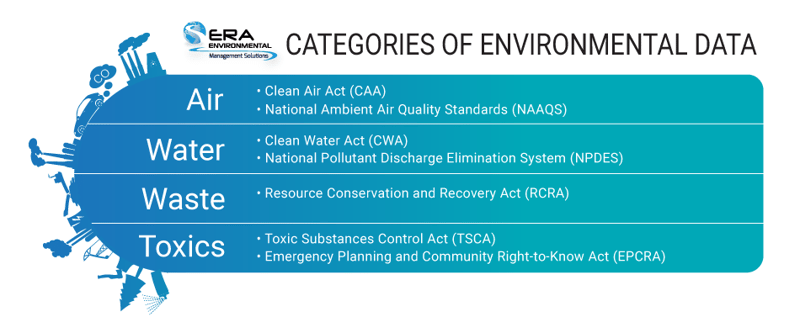It's no secret that excellent environmental data management is the foundation of any successful EH&S department. In fact, EH&S professionals are keen to achieve this by improving their data collection for relevant environmental reports. To encourage you to collect relevant data, this blog will outline the types of data required by different regulations and some uses of environmental data other than environmental reporting.
What are the Different Categories of Environmental Data?
Facility processes can encompass a broad range of environmental management activity including air emissions management, wastewater disposal, solid waste disposal, and toxic substances. The acts that regulate these include:

- Air. The Clean Air Act (CAA) regulates stationary and mobile air emission sources to establish National Ambient Air Quality Standards (NAAQS) for protecting public health and monitoring the release of Hazardous Air Pollutant Emissions (HAPs). Effectively collecting emissions data on greenhouse gases (GHG) and tank emissions can help you with air reporting.
- Water. The Clean Water Act (CWA) makes it unlawful to release pollutants into bodies of water unless you hold a permit. The National Pollutant Discharge Elimination System (NPDES) regulations monitor reporting state requirements and water treatment.
- Waste. The Resource Conservation and Recovery Act (RCRA) addresses solid waste control and has subtitles covering hazardous and non-hazardous waste. If your facility produces hazardous waste, you are required to file the National Biennial RCRA Hazardous Waste Report.
- The Toxic Substances Control Act (TSCA) covers polychlorinated biphenyls (PCBs), asbestos, radon, and lead-based paint. The Emergency Planning and Community Right-to-Know Act (EPCRA) addresses chemical safety hazards. EPA enforces EPCRA using TRI and Tier II reporting for groups of defined hazardous chemicals.
The highlighted categories of environmental regulations undergo strict compliance monitoring by the EPA. Report data is available on public databases, which is why your company should be mindful of the applicable regulations when collecting environmental data.
What Environmental Data Should I Collect for My Industrial Sector?
Although regulation requirements may overlap across industries, variations in materials and processes mean that EHS experts must be mindful of the nuances of environmental data tracking in their specific industrial sector. Below are a few examples of variation in industry-specific data collection. The list is by no means exhaustive, it highlights industries with the most variation in types of environmental data required.
Oil and Gas Industry
Oil and Gas emissions originate from extraction, transport, loading and storage processes. Product storage in tanks is regulated, and it is essential to have strong recordkeeping for tank operations, contents, quantities, and locations to calculate emissions accurately. Meticulous recordkeeping will help ensure accurate emissions calculations for your permit compliance reports.
Other Oil and Gas practices, such as wastewater discharges from exploration and drilling, have different data requirements. Emissions from specific products are also closely monitored; for example, in November 2021, the EPA proposed a rule to limit methane emissions from Oil and Gas extraction activities. These updates should be taken into consideration when collecting environmental data.
Automotive Industry
Data for the automotive industry covers general supply chain information and vehicle assembly steps and requires extensive knowledge of the chemicals and materials at the assembly plant. Assembly processes such as painting produce VOCs and HAPs emissions. Overlooked clean-up methods such as purging or flushing the paint guns have waste that is difficult to speciate because it is mixed with paint and other materials. Effective data collection in this instance would require environmental data management software that can calculate the percentage of paint vs. flushing solvent in your waste mixture for accurate air emissions credit calculation. These specific scenarios should be kept in mind when collecting data within your facility.
Supply chain members should also track their environmental data to prove to potential partners that they are a reliable source of materials. For example, General Motors is rebuilding its supply chain to emphasize responsibly sourced materials. If your company is a Tier I or Tier II automotive supplier, you can prove to OEMs like General Motors that you align with their environmental goals with adequate environmental data.
Chemical, Paints, and Coatings Industry
Manufacturing operations store infinite chemicals that may or may not be hazardous. Hazardous chemicals must be reported for programs such as Tier II and TRI. TRI also includes a pollution prevention report where facilities highlight their efforts with reduction of hazardous chemicals in their processes or changing equipment to limit waste that causes various forms of pollution. These facilities also produce a large amount of waste that should be reported under programs such as the Biennial Waste report. All these reports require inventory and process tracking along with knowledge of chemicals used.
Extensive chemical knowledge can be enhanced by accurate SDS authoring. Having full 16-section SDSs and SDS Authoring services help you to correctly identify specific chemical properties for air compliance (GHGs, NESHAPs, Emissions (VOC, HAPS, VHAPS), Tier II, and TRI). Seeing as environmental data overlaps with air compliance data, it is essential for your company to make use of an Environmental Management software solution to eliminate data redundancies from the individual collection for each function.
Importance of Environmental Data
High-quality environmental data is vital for more than just meeting reporting requirements. It is also helpful for your company’s personal goals. The EPA and other organizations set emissions goals that can be met by effectively managing your environmental data within your company. Examples of goal-related data use include EPA energy-saving goals and your company’s personal sustainability goals.
EPA Energy Saving Reward Program
The EPA employed the ENERGY STAR Challenge for industry and manufacturing plants. They agreed to reduce the energy intensity by 10% in 5 years. In 2021, 580 companies doubled this goal by reducing energy intensity by 19% and preventing 17 million metric tons of GHG emissions. With full knowledge of your GHG emissions, you can quickly identify modifiable energy sources to support energy reduction goals.
Sustainability Reporting Goals
Most companies are attempting to reach a zero net carbon goal, increasing requirements for effective data collection and reporting. This means they invest more in data processing software and adopt reporting strategies such as the Global Reporting Initiative (GRI), allowing goal establishment and different data communication methodologies alongside their annual reporting. According to KPMG, by the end of 2020, 75% of the world's 250 largest companies had begun using GRI. This, alongside your annual reporting, can give you more comprehensive environmental data to communicate sustainability efforts to stakeholders.
Overall, environmental data is essential in compliance reporting and overall participation in national emissions goals. To learn more about environmental data management, ERA has an eBook that highlights how to streamline your environmental data for effective reporting.
This Blog Was Co-Authored By:





Comments